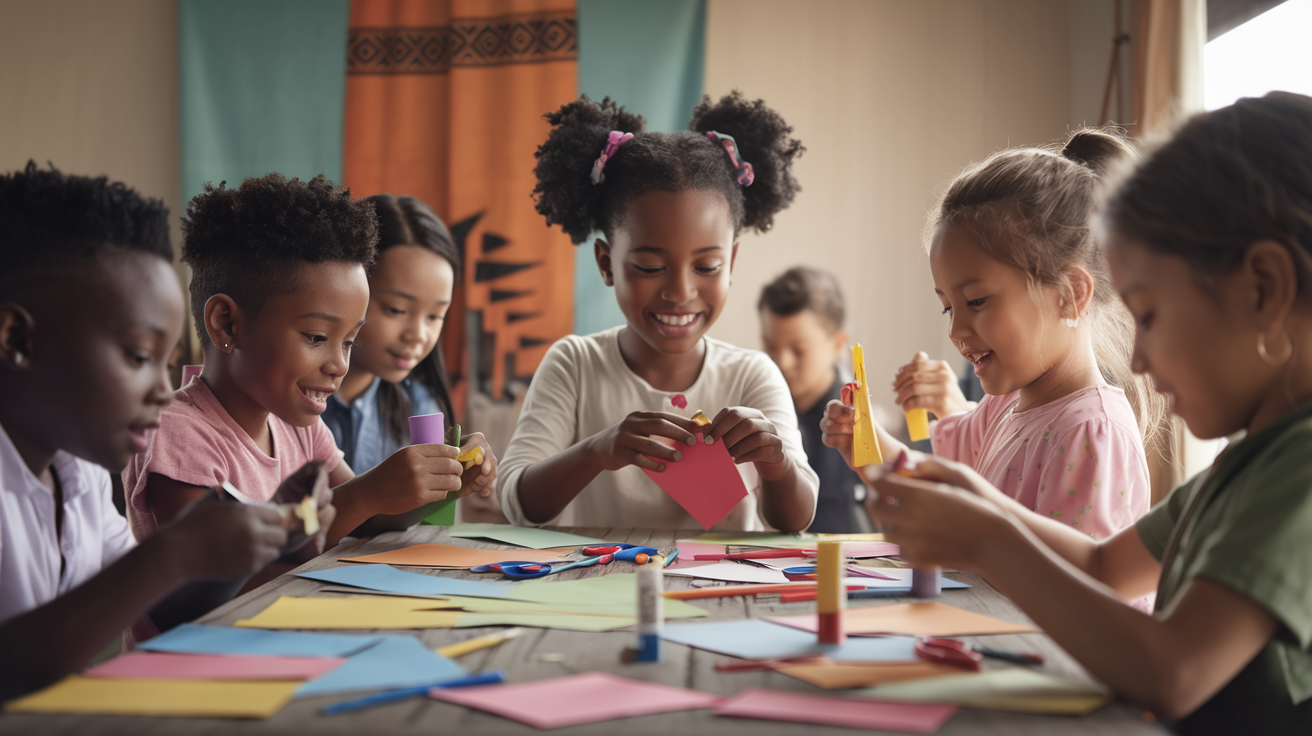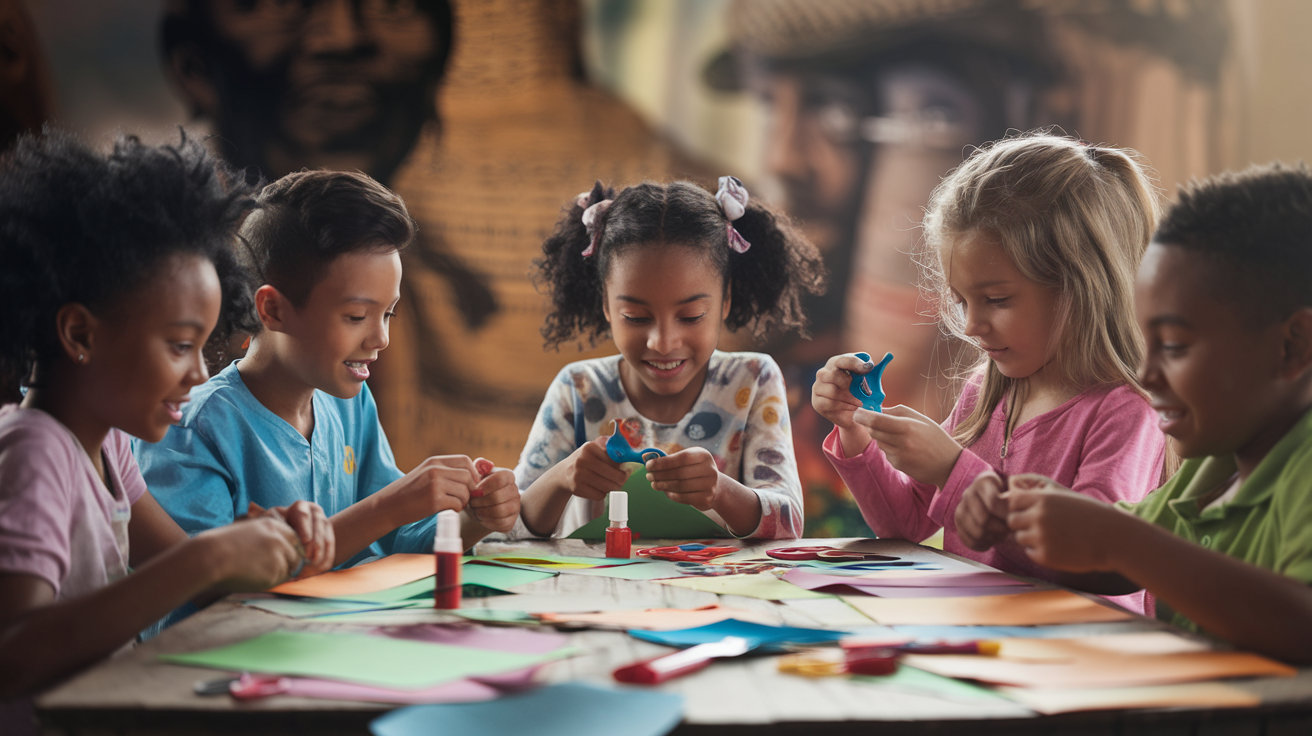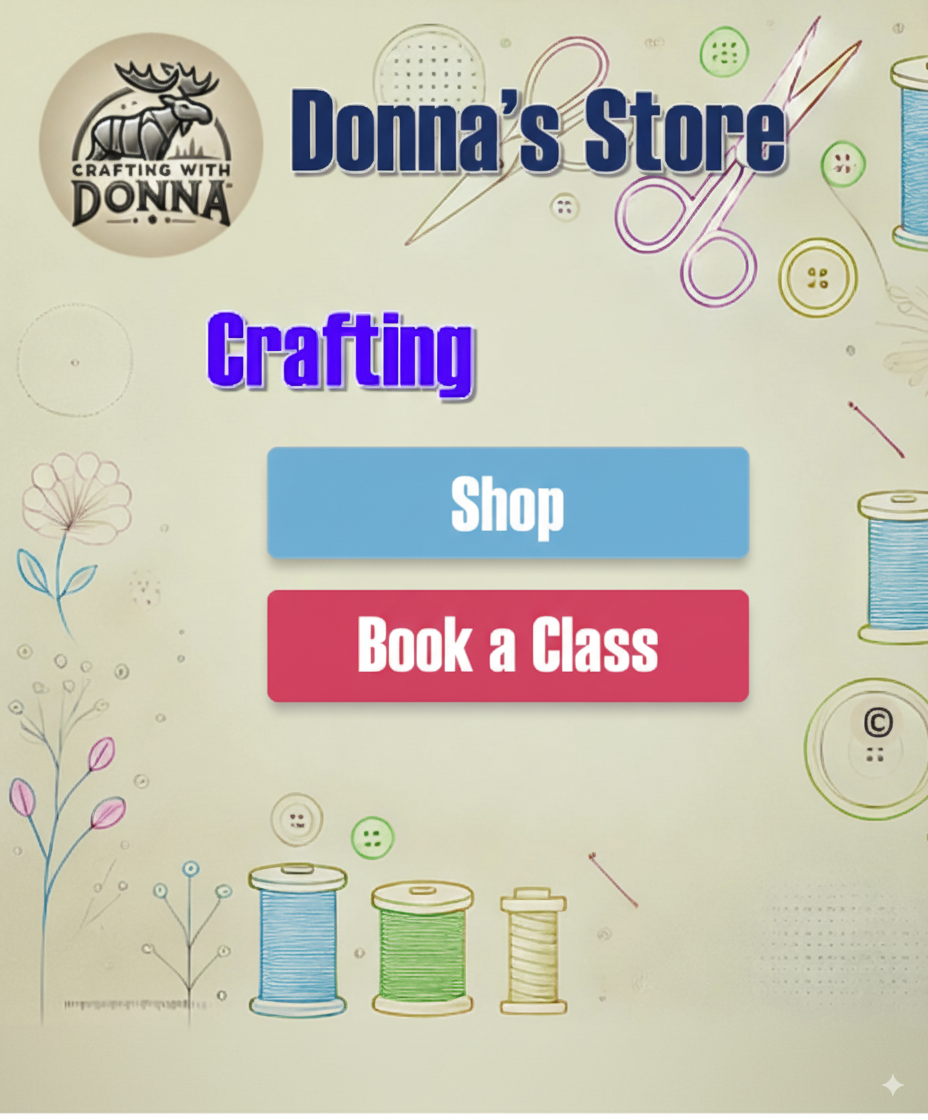Learning About Angola Through Kids Craft Activities

Angola offers a world of bright colors, exciting traditions, and interactive learning for children eager to explore unique cultures. Angolan crafts capture the spirit of Southwestern Africa, helping children dive into geography, history, and daily life while building creativity and cultural awareness.
Clay baskets inspired by traditional weaving, playful mask making, and drawing the Angolan flag are just a few ways to transform curiosity into hands-on discovery.
With every craft creation, kids strengthen fine motor skills, embrace cultural empathy, and expand their global horizons through memorable, step-by-step activities.
Next, journey deeper by experimenting with paper crafts inspired by Angolan art.
Angola, a nation in southwestern Africa, presents a tapestry of vibrant traditions and unique crafts perfect for engaging young minds.
These children’s activities serve as gateways to exploring Angolan culture, history, and daily life, simultaneously fostering creative expression and cultural awareness. Utilizing accessible materials, various educational projects allow children to participate in hands-on learning, enhancing cognitive development and artistic development.
Exploring Traditional Angolan Crafts
The artisanal skills of the Angolan populace are rich with opportunities for children to learn.
Crafting inspired by Angolan art allows for deep dives into diverse histories and heritage exploration.
These activities enhance dexterity enhancement and promote a better understanding of traditional designs.
- Clay baskets: Shape pinch pots from clay, inspired by traditional African weaving, dry, and paint them in earthy tones to mimic authentic designs, fostering fine motor skills and an appreciation for crafting techniques.
- Mask making: Creating masks using readily available materials reflects the vibrant traditions seen in Angolan daily life and celebrations, encouraging symbolic representation.
- Doll making: Explore doll making crafts with cloth, beads, and embroidery to replicate styles and fashions of Angolan communities, enhancing dexterity and cultural empathy.
Paper Crafts and Symbolic Representation
Discovering Angolan art through paper crafts allows children to create colorful projects that echo the rich patterns found in textiles and local adornments. These activities offer a unique way to engage with Angolan culture, learn about symbolic representation, and practice sustainable practices. Such projects connect children with the continent’s diverse histories and peoples, promoting cross-cultural appreciation.
- Angolan flag: Draw or color the Angolan flag using printable worksheets to introduce the country’s symbols and history in a fun, visual format, aiding historical understanding.
- Calabash bowls: Craft calabash bowls from papier-mâché or recycled materials, echoing Angola’s use of gourds for food and decoration, offering both cultural insight and an eco-friendly art project, promoting material utilization.
Creative Expression and Skill Building
Joining in painting workshops or recycled-materials art classes, inspired by programs in Angola, helps build practical skills and self-expression while learning about local art forms and artisanal skills. These skillbuilding activities contribute to holistic exploration and artistic development.
- Recycled art: Use recycled paper to make Angolan patterned paper beads—cut strips, sketch geometric motifs, roll, and glue for vibrant necklaces or decorations, fostering sustainability and creativity.
- Landmark models: Assemble paper or cardboard models of Angolan landmarks, such as the Fortress of São Miguel or Map of Angola, to teach geography and historical architecture, aiding geographical exploration.
Discover Angolan art through paper crafts
Angolan art traditions inspire children to create colorful paper crafts that echo the rich patterns found in textiles and local Angolan culture. Traditional folding techniques might vary, but every project celebrates detailed design, much like the intricate beadwork and basketry made by Angolan artisans. For an easy educational activity, use recycled paper to make Angolan patterned paper beads—cut strips, sketch geometric motifs, roll, and glue for vibrant necklaces or decorations. Each bead can represent a story, mirroring how Angolan crafts often convey history and meaning. To protect delicate creations, apply a light layer of watered glue, preserving these sustainable recycled art projects as lasting mementos of cross-cultural learning.
Cultural Significance of Paper Craft
Angolan art is rich with traditions that heavily influence paper crafts, offering children a unique window into the nation’s heritage. While specific traditional paper folding techniques may not be as widespread as other forms of Angolan artistry, the influence of intricate patterns found in textiles, beadwork, and daily adornments is evident in contemporary Angolan paper crafts. These decorative elements often carry symbolic representation, connecting the craft to deeper cultural narratives and community traditions. Children can explore these motifs, translating them into their own creations.
Angolan crafts often serve as storytellers, passing down history and meaning through their designs.
Beginner-Friendly Paper Craft: Angolan Patterned Beads
A wonderful educational project involves using recycled paper to create Angolan-inspired patterned beads.
Steps:
- Gather recycled paper, scissors, a ruler, glue, and a skewer or pencil.
- Cut strips of paper, approximately 1 inch wide and 6 inches long.
- Encourage children to sketch geometric motifs or patterns reminiscent of Angolan textiles onto the paper strips, focusing on decorative elements and traditional designs.
- Apply a thin line of glue along one edge of the strip.
- Starting with the wider end, roll the paper strip tightly around a skewer

Explore Angolan culture with doll making
Angolan crafts skillfully convey profound symbolic meanings through traditional doll features; the Mumuila boneca serves as an exemplar, illustrating how ornaments, headdresses, and characteristic postures represent life stages, fertility, and ancestral wisdom central to Angolan culture [1]. Material utilization thoughtfully reflects Angola’s diverse ecosystems; employing plant fibers, natural cotton, or locally sourced clay directly connects craft creation with the region’s environment, actively embracing sustainability and ecofriendly art practices [1][2].
Community traditions prominently feature dolls in rituals and educational rites; observe how passing a fertility doll from sister to sister fosters cultural empathy and prepares girls for adulthood [1].
For crafting durable hand-stitched dolls, carefully select sturdy fabrics and practice meticulous embroidery, beadwork, or secure stitching methods to ensure longevity and capture authentic Angolan style.
Why learn African weaving techniques?
Angolan art traditions are vividly demonstrated in basket weaving, where intricate, vibrant patterns historically served as a form of communication and status representation within Angolan society, rendering artistic development and cultural awareness accessible to all age groups [3].
Skillbuilding activities focused on weaving empower artisans, opening avenues for income generation through the creation of distinctive crafts like clay baskets or calabash bowls that mirror Angolan daily life and promote sustainable material utilization [3]. Symbolic representation is powerfully evident in woven patterns designed to encode ancestral knowledge and communicate identity—often reflecting elements seen in the Angolan flag and the region’s esteemed world heritage.
When embarking on authentic African weaving projects, source natural raffia, cotton, or recycled art materials from ethical suppliers to thoughtfully support holistic exploration and nurture artisanal skills inherent in Angolan crafts.
Craft Focus Cultural Significance Material Practices Skill Development Traditional Doll Making Represents life stages, fertility, and ancestral wisdom Utilizes plant fibers, cotton, or clay for sustainability Fosters cultural empathy and prepares for adulthood Basket Weaving Communicates status and encodes ancestral knowledge Employs natural raffia, cotton, or recycled materials Empowers artisans and generates income Creating with Angolan Crafts and Beadwork
Angolan crafts intricately weave stories and traditions, with beadwork standing as a vibrant testament to Angolan culture and daily life. Each bead color and its placement carries profound meaning:
Symbolism in Angolan Bead Colors
Angolan art imbues beadwork with deep symbolic representation.
The careful selection of bead colors communicates various messages:
- Red signifies vitality, passion, or ancestral strength, reflecting the spirit of the Angolan populace.
- Green represents fertility, renewal, and prosperity, mirroring the bountiful natural resources of Southwestern Africa.
- White denotes purity and spiritual clarity, connecting to the country’s spiritual beliefs within Angolan culture.
- Blue offers peace, protection, and wisdom, important elements in fostering community harmony and understanding.
- Yellow brings happiness, wealth, and creativity, celebrating the joyous aspects of life and Angolan celebrations.
Integrating Beadwork into Contemporary Fashion
Angolan crafts are increasingly influencing modern fashion trends. Beadwork now adorns jackets, bags, and shoes, blending timeless tradition with fresh styles, and showcasing the evolving nature of Angolan art. This integration demonstrates effective material utilization and artistic mediums for craft creation.
Ethically Sourcing Beads for Angolan-Inspired Crafts
The process of ethically sourcing beads for Angolan-inspired crafts involves mindful choices. Prioritizing fair trade suppliers and incorporating recycled art materials ensures support for Angolan artisans. This approach fosters sustainability and responsible craft creation, promoting cross-cultural appreciation.
Crafting Intricate Angolan Bead Patterns
For enhancing artistic development and skillbuilding activities, mastering intricate bead patterns by hand is rewarding. Techniques like threading beads to recreate authentic Angolan designs or practicing the peyote stitch allow for hands-on learning and refine fine motor skills. This practice elevates both the craft and cultural awareness, facilitating a deeper connection to Angolan culture.
What Are Calabash Bowls Used For?
Calabash bowls hold a significant place in Angolan daily life and ceremonies, serving meals and beverages during community traditions and celebrations. These versatile vessels are crafted from durable gourds, showcasing natural waterproofing qualities ideal for storage and decoration across Angola, embodying both practicality and sustainability. Angolan art frequently features creative expression through the decoration of these bowls, with artisans carving, painting, or burning intricate patterns inspired by symbolic representation and traditional designs. To maintain aged bowls, a gentle cleaning with a soft cloth and natural oils is recommended, ensuring the beauty and heritage of Angolan crafts are preserved for heritage exploration and ongoing artistic mediums.
Cultural Context of Calabash Use in Angola
Angolan culture deeply values the use of calabash bowls in daily routines and communal gatherings. These bowls are integral to Angolan daily life, from serving food and drink during family meals to playing key roles in significant ceremonies and Angolan celebrations, strengthening community bonds and facilitating interactive learning.
Natural Properties for Storage and Decoration
The natural properties of gourds make them exceptionally suitable for storage and decoration in Angola. Their inherent durability and natural waterproofing qualities ensure the longevity of the bowls. This material utilization reflects a deep understanding of nature’s offerings within Angolan crafts, promoting ecofriendly art and sustainability.
Traditional Methods for Crafting and Decorating Calabash Bowls
Traditional methods for decorating and waterproofing calabash bowls in Angola involve skilled artisanal techniques. Artisans often carve or etch intricate patterns, painting designs that hold symbolic representation, or even burn designs onto the surface, creating unique pieces of Angolan art. These decorative elements enhance their aesthetic appeal and cultural significance, contributing to accessible materials for craft creation.
Maintaining Aged Calabash Bowls with Angolan Influences
To preserve the beauty and heritage of aged calabash bowls, a gentle cleaning approach is best. Using a soft cloth with natural oils helps maintain their condition and appearance. This care ensures that these pieces of Angolan crafts continue to be appreciated for their historical understanding and role in folk art, supporting heritage exploration.
- Bead colors in Angolan crafts carry specific meanings: red for vitality, green for fertility, white for purity, blue for peace, and yellow for happiness.
- Angolan beadwork is being integrated into contemporary fashion, adorning items like jackets and bags, showcasing the evolving nature of Angolan art.
- Calabash bowls are crafted from durable gourds and are used for serving meals and beverages in Angolan daily life and ceremonies.
- Traditional methods for decorating calabash bowls in Angola include carving, painting, and burning intricate patterns inspired by symbolic representation.
Making Angolan Flag Crafts
Embark on a creative journey to explore Angola’s national symbol through engaging craft activities. The Angolan flag, with its distinct colors and emblems, offers a rich narrative of history, unity, and identity, making it an ideal subject for hands-on learning and creative expression for children.
As kids study the flag’s bold red and black bands, they discover how red honors Angola’s struggle for independence, while black celebrates its African heritage and the diverse histories of the Angolan populace.
The central yellow emblem—a cogwheel, machete, and star—symbolizes agricultural and industrial workers, as well as solidarity and progress within Angolan culture and Southwestern Africa[4][2][3].
Crafting the Angolan Flag
Recycled art materials like felt, popsicle sticks, or fabric scraps can be used to build tactile flag collages or mobiles, transforming the Angolan flag into three-dimensional crafts ideal for children’s activities and skillbuilding activities.
These accessible materials, when utilized creatively, allow for a tactile engagement with the flag’s design.
Symbolic representation is key when letting kids sketch and then craft their own personal flag designs, drawing inspiration from Angolan motifs to foster national pride, artistic development, and cross-cultural appreciation.
Encouraging kids to create Angolan crafts not only teaches history and symbolism, but it also strengthens their connection to Angola’s heritage through creative expression and interactive learning[1][3][4].
This approach to learning about the Angolan flag allows for a deeper appreciation of the nation’s stories and traditions.
Recycled Art for Angolan History
Angolan art provides a compelling opportunity to transform everyday discarded items into impactful teaching tools, connecting young learners with historical understanding and cultural awareness. Kids can craft recycled sculptures representing Angola’s landmarks, such as the Fortress of São Miguel, using eco-friendly art techniques with cardboard, bottles, or old containers, reflecting traditional designs in new ways.
These recycled art projects mirror the resourcefulness ingrained in Angolan culture and the Angolan populace, plus celebrate the country’s ingenuity during times of challenge and change.
They also highlight the concept of sustainability in craft creation.
Depicting Historical Moments and Landmarks
- Material utilization in these educational projects lets children depict historical moments—like the Angolan Revolution—by creatively reimagining famous figures or national symbols with accessible materials, thereby enhancing cognitive development.
- Building landmark models or folk art through recycled creations promotes sustainability, dexterity enhancement, and a deeper empathy for Angolan history, while nurturing skill-building activities and artistic mediums, offering a holistic exploration of the Angolan culture.
These activities unite heritage exploration and creative expression, imparting lessons about Angola’s resilience and encouraging holistic exploration through craft creation, making Angolan history come alive.
Crafting Material Symbolic Representation Learning Outcome Felt, popsicle sticks, fabric scraps Red for independence struggle, black for African heritage Tactile engagement with flag design, creative expression Cardboard, bottles, old containers Landmarks like Fortress of São Miguel, traditional designs Resourcefulness, sustainability, historical understanding Accessible materials Angolan motifs, historical figures, national symbols National pride, artistic development, cognitive development The Tapestry of Angolan Exploration and Artistic Heritage
Linking Exploration to Cultural Diffusion
The Angolan populace, a vibrant community in Southwestern Africa, possesses a rich heritage where Angolan culture intricately intertwines with the narrative of geographical exploration. Early expeditions across Angola’s diverse terrains, from fertile river valleys to mineral-laden plateaus and expansive coastlines, became conduits for the spread of cultural practices and the evolution of Angolan art forms.
This mingling of peoples, including explorers, traders, and local inhabitants, fostered a dynamic exchange that solidified traditional designs within communities.
Specifically, the discovery of abundant natural resources, such as unique clays, precious minerals, and varied plant fibers, directly sculpted Angolan crafts.
These discoveries fueled the mastery of techniques evident in African basket weaving, the creation of functional items like calabash bowls, and intricate beadwork, showcasing the skillful material utilization central to craft creation.
Visual Echoes of Mapping and Modern Interpretations
Advancements in mapping techniques unveiled during exploration found visual representation within Angola’s rich tapestry of folk art.
These cartographic innovations were reflected in patterns adorning textiles and in the abstracted journey lines etched into pottery, demonstrating a unique form of symbolic representation. Modern initiatives can honor this legacy by engaging in recycled art projects that echo the resourcefulness inherent in Angolan heritage, or through painting workshops that draw inspiration from Angola’s significant landmarks.
Such activities not only celebrate the nation’s ongoing commitment to creative expression but also foster a deeper historical understanding and promote artistic development, bridging past discoveries with contemporary artistic mediums.
This approach to holistic exploration can be made accessible through printable worksheets and step-by-step guides that connect community traditions with sustainable practices.
Engaging Children with Angolan Culture Through Crafts
Hands-On Learning and Cultural Awareness
Angola, a nation situated in Southwestern Africa, offers a rich canvas for children’s engagement through its diverse heritage and vibrant traditions, particularly its unique crafts, which are ideal for hands-on learning. Educational craft projects centered on Angola serve as an excellent avenue for children to explore its geography, culture, and history, simultaneously nurturing their creativity and enhancing cultural awareness.
A fantastic starting point involves creating clay baskets inspired by traditional Angolan weaving, where shaping pinch pots from clay, allowing them to dry, and then painting them in earthy tones can effectively mimic authentic designs. Such activities are excellent for dexterity enhancement and develop fine motor skills.
Drawing or coloring the Angolan flag, with the aid of step-by-step guides or printable worksheets, offers a fun, visual introduction to the country’s symbols and history, fostering national pride and a basic understanding of visual communication.
Crafting African-style necklaces or masks using accessible materials like paper, beads, and yarn provides a tangible connection to the vibrant traditions seen in Angolan daily life and celebrations, promoting cross-cultural appreciation.
Eco-Friendly Creations and Skillbuilding
Crafting calabash bowls from papier-mâché or other recycled materials directly echoes Angola’s historical use of gourds for both food storage and decoration, offering both cultural insight and an ecofriendly art project that supports sustainability. Assembling paper or cardboard models of prominent Angolan landmarks, such as the Fortress of São Miguel or a map of Angola, can effectively teach geography and the nuances of historical architecture, encouraging cognitive development.
Participating in painting workshops or art classes focused on recycled materials, mirroring programs found within Angola, helps build practical skills and fosters self-expression, further deepening an appreciation for local art forms. Exploring doll-making with fabric, beads, and embroidery allows children to replicate the styles
- Angolan culture and art forms evolved through geographical exploration and the exchange of practices between explorers, traders, and local inhabitants.
- The discovery of natural resources like clays, minerals, and plant fibers directly influenced Angolan crafts, including basket weaving, calabash bowls, and beadwork.
- Mapping techniques from exploration periods are reflected in Angolan folk art through patterns on textiles and etched pottery, serving as symbolic representations.
- Educational craft projects for children, such as making clay baskets or decorating calabash bowls from recycled materials, foster cultural awareness, dexterity, and an appreciation for Angolan traditions.




